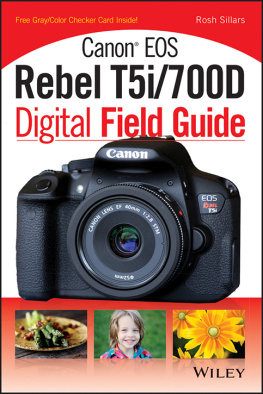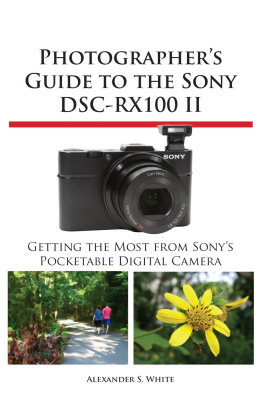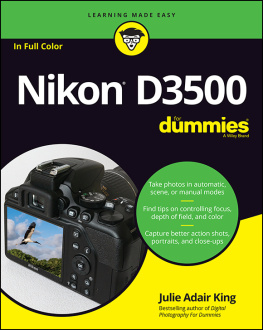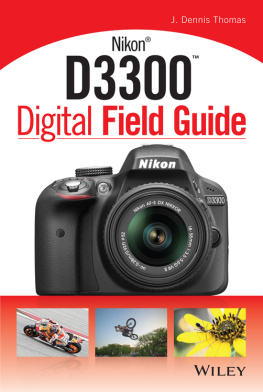The Friedman Archives Guide to Sonys Alpha 6300
Professional insights for the experienced photographer
by Gary L. Friedman
Version 1.03
ISBN 978-1-365-18832-9
Published By |
The Friedman Archives Press |
Copyright 2016 Gary L. Friedman All rights reserved. No portion of this book may be reproduced either in print or in any digital format without express written permission . |
On The Cover
Newborn photography is harder than it looks, and I talk about the unobvious details in my blog post here: http://bit.ly/1YSsVCy . This photo was taken with a Minolta 100mm f/2.8 macro lens and LA-EA2 A-mount converter.
For Those of You Who Bought the Printed or E-Reader Edition
There are a LOT of demonstrative illustrations in this book that kind of lose their effectiveness when converted to black-and-white. And some are difficult to see on e-book reader screens like the original Kindle.
And so to offset these problems Im offering a free, full-color, instantly-downloadable .pdf file of this ebook to all customers who bought printed books (be they color or black-and-white), or who purchased this work through the Amazon Kindle, Apple, Barnes and Noble, or any other e-reader store. (The original .pdf file really does offer a superior user experience. Think of it as the directors cut regarding how the author intended the work to be seen.)
To get your free .pdf file, just email me ( ) with a copy of your receipt and Ill send you a download link. Such a deal!
About the Photos
The photo pages preceding each chapter are images from the www.FriedmanArchives.com stock photo website, and were taken with a wide variety of different cameras over the past 30 years.
About the Author
www.FriedmanArchives.com, is associate editor of f2 CameraCraft magazine (a thoughtful periodical which provides tremendous insights as well as showcasing inspirational images), and gives highly-acclaimed digital photography seminars worldwide for those who wish to improve their creative photography and learn the essentials in an intuitive manner. Because he teaches seminars worldwide, Mr. Friedman stays in touch with the concerns and challenges of serious amateurs the kinds of people who buy cameras like the A6300.

This is me examining a camera very closely so I can write a very detailed book on it.
Before graduating to photography he was a rocket scientist for NASA 's Jet Propulsion Laboratory (you know, those guys who landed probes on Mars and sent robots like Pioneer, Voyager, Galileo, Pathfinder, Spirit, and Discovery to explore the outer solar system), where he patented the image authentication system used in high-end Canon and Nikon cameras. He has been published in books, newspapers and magazines worldwide, and was listed in the Guinness Book of World Records while in college (go ahead and search the FriedmanArchives.com website if you want to find out what he did to get included).
Despite his mastery of the technical background, Mr. Friedman has an approachable and easy-going teaching style that makes his books a pleasure to read. You can read more about his background at http://friedmanarchives.com/bio.htm.
Table of Contents

Chapter 1 In a Nutshell
The E-mount platform has taken off far beyond what Sonys original designers had envisioned. Once designed especially for cell phone shooters looking for a small, friendly, and high-quality upgrade, this new format has now evolved to provide Sony with their best-selling cameras ever (Im talking specifically of the A6000 here) and has even garnered the respect in the professional industry with their full-frame A7 series.
So what can Sony do for an encore? Well, the first thing to do is stick with what works, and then add features that would earn the engineering team no shortage of accolades, starting with 4K video, 11+ frames per second still images, and an even more improved autofocusing algorithm that can track moving subjects with the best of them. Congratulations, youve purchased one of the most technologically advanced cameras on the planet!
In this book Ill be covering every single feature and setting in detail, but as always it helps to start with an overview of whats new.
1.1 What's New?
1.1.1 A new 24 megapixel sensor
Sony has had 24 megapixel, APS-C-sized sensors for a few years now. But two major improvements have been made to the sensor which graces your A6300:
1) A whopping 425 Phase-detect pixel pairs are now baked right into the sensor, which offer faster and more accurate autofocusing than the older contrast detect AF used in prior cameras like the NEX-7. (More about the differences in a minute.) (See to get a feel for just how smothered in focus points this new sensor is.)

Figure 1-1: 425 focusing points baked right into the sensor provides the best focus-tracking AF experience Sony has ever offered (and rivals some considerably-more-expensive DSLRs). |
2) Copper-based wires that allow the data to be siphoned off the sensor much faster than before. This results in new capabilities such as 4K video, high-frame rate (i.e., slow-motion) video, and 11+ pictures-per-second still shooting modes. And it also enables a new feature the ability to revert to live view between frames at all but the very highest continuous shooting rate something that sports photographers have been asking for. This new sensor can deliver!
TIP : People do side-by-side video comparisons between different cameras all the time, but this one impressed me. Tony & Chelsea Northrup created a youtube video comparing a Canon 80D, 70D, A6300, and Lumix GH4 at various ISO settings. They all start looking the same but by the time they get to ISO 25,600 the A6300 is head and shoulders above the others in terms of noise and color (and autofocus). Watch this comparison for yourself: https://youtu.be/trKuhDRkFUs |
1.1.2 Sony's Best Focus Tracking
Sony has been toying with this capability ever since the A99, but were never able to solve all the technical problems associated with it until now. In all previous models, any on-sensor phase detect array would only kick in after the focus had been confirmed via other means. But now the large array of phase-detect AF points (more than on any other camera ) can be used to get focus, and to track moving objects. Whats more, these same phase-detect pixels can now directly dri ve autofocus lenses from Canon and Nikon using an intelligent adapter, just as quickly as if they were on a native body!

Figure 1-2: The ability to follow-focus has vastly improved, making it the best mirrorless camera in the world to track moving subjects. (And 11 pictures per second is pretty useful too! Now you have more good pictures from which to choose.) |
A Primer Phase Detect vs. Contrast Detect










